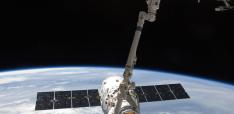Planes, drones and agricultural yields

International Media Centre – G20 Buenos Aires Summit. Rarely do we talk about the environmental destruction that aeroplanes wage on the environment. This will not be easy to change. Instead, it’s time we look to the positive ways in which advanced aviation technology is being mobilised to help solve one of the world’s most pressing problems – food insecurity.
Sat inside the international media centre in Buenos Aires, every 10 minutes or so the 2018 G20 media cohort are interrupted by the sounds of planes soaring above us at what sounds like extremely close range, and landing just a few kilometres away at the Aeroparque Internacional Jorge Newbery.
We’re told it’s probably world leaders and their (often massive) entourages arriving at the summit. In fact, we have live footage of it on the big screens in front of us. We watched as the US and Saudi Arabia arrived with 16 planes between them, and waited for Angela Merkel for whom German technology (for once) failed as her plane turned back and she arrived a day late. Vorsprung Durch Technik!
And yet, although it’s all very exciting (our desks actually rattle a little when they soar past), it is impossible to avoid wondering how necessary, if at all, any of this air travel is in the 21st century. This is especially so when we consider the fact that sustainability and climate change are so high up on the G20’s agenda.
A similar point was raised earlier this year when experts and leaders were flown to the World Economic Forum (which, with little sense of irony, largely focused on carbon emissions) in a ludicrous number of private jets.
Maybe it sounds a little dramatic – after all, we shouldn’t really be complaining about world leaders travelling in a few planes in order to come together to try and reach consensus on the world’s most pressing issues, right? Especially in a world as divisive as ours is currently. But to be honest, it bothers us.
International travel is largely bypassed in discussions on climate change. Aeroplanes are currently the most damaging mode of transport for the environment in terms of fossil fuel combustion. It is quite terrifying to consider that a round-trip from New York to California will generate about one fifth of the greenhouse gases that your car will emit in a year.
And while electric smart cars, cycling to work, eating less meat and recycling plastic are the default options presented to us in order to be ‘greener’, rarely do we speak about reducing our carbon footprint generated via international travel.
Perhaps that’s because it’s a lot harder to give up: after all, if we had to pick, we’d probably choose to go greener via recycling or walking to work rather than give up our holidays. But with globalisation likely to intensify, we can equally expect aeroplane travel to continue taking off, so to speak, causing setbacks in climate change pledges.
But not all planes are bad. Or, rather, the emissions they create can be put to good social use.
Skip to some other parts of the world, and we can find examples of modern aviation technology being mobilised in a highly positive way. Unmanned aerial vehicles (UAVs) or drones are, for example, increasingly used in sustainable agricultural practices.
As the G20 has picked up on this year, food security is one of the most pressing issues of our time. As the world population is expected to reach 9.7 billion people by 2050, agricultural yields will need to increase by a staggering 70 per cent in many places, and yet the amount of arable land and soil available to us is sharply declining. In the meantime, climate change continues to ravage the already scarce resources available to us.
So how can aviation technology be used in a positive way?
Unlike aeroplanes, drones actually benefit the environment due to their use in what has been coined ‘precision agriculture’. They can be fitted with crop-spraying systems, and sensors which detect soil fertility, livestock conditions, land temperatures and water levels, to increase the productivity and quality of farming yields. In this way, as our populations increase to unprecedented levels, drones can help to ensure we are utilizing every bit of land and conserving the earth’s finite resources.
There we have it – aeroplanes versus drones. Though completely different, the story of each highlights that it’s up to us how we choose to use technology. For the countries of the G20, such thinking will be crucial in the coming years, as issues of climate change and food security will come to shape policy.
The broader question is, as ever, the political one: if, for the sake of the planet, we have a finite amount of aviation that we can use, particularly when it comes to conventional large-scale flight, who gets to decide what – and on what basis – it is used for? What is the most socially useful justification for flying, and how can it be rendered as equitable as possible?
Questions like this, which imply rationing and the fair sharing of resources in a world presently dictated by market logic, remain stubbornly off the G20’s agenda. One day, they will have to come into the discussion if we are to give our children a hospitable planet.
G20 Team: Martina Alvarez, Sol de Bernado, Matthew Bishop, Holly Barden, Holly Clarke, Hugo Dobson, Camila Dolabjian, Jamie Firby, Martina Gallego, Eleanor Harris, Daniela Ibañez, Eitan Kiperman, Victoria Lapadula, Marianne Quinn, Alex Reynolds, Sofía Sant, Vipran Srivastava, Hayley Stevenson and Tom Wymer.
Image credit: Paul Reid via Flickr (CC BY 2.0)


